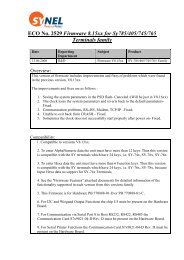TimeLOG Version 9.3 - Synel
TimeLOG Version 9.3 - Synel
TimeLOG Version 9.3 - Synel
- No tags were found...
Create successful ePaper yourself
Turn your PDF publications into a flip-book with our unique Google optimized e-Paper software.
Creating and Adapting Work Rules <strong>TimeLOG</strong> <strong>Version</strong> <strong>9.3</strong>73 PeriodicBalancing74 Pay periodbalancingSeven fields containing a list of pay categories in ascending order. Balancingcomplements regular hours not worked with hours from other pay categories. Hours aredrawn from the first pay category listed, until all regular hours not worked arecomplemented. This is repeated for the next pay category.The number of regular hours not worked is the number of expected work hours, minusactual regular hours recorded.The time recorded in time classifications that is not available for balancing (the Balance?check box is unmarked) will be added to pay category totals after balancing and after allother pay period calculations have been completed.This field defines the order in which the pay periods, reported by the by the employee forthe pay period, are balanced.Note: The pay periods that can be used are defined in the <strong>TimeLOG</strong> Dictionary see“Editing a pay category” on page 46.Note: If this setting is not used, the pay periods are calculated from the work daydefinitions.75 Grace fwd. The amount of times that the employee may work less than the expected hours for the payperiod, and still be recorded as having worked Expected daily hrs. If parameter 64 (OTperiod) is defined, then the Grace fwd field is calculated separately for each overtimeperiod.Note: This field is only active if parameter 69 the (OT Calc. Method) is defined as Periodic.76 +77 Rnd. intervaland Cut-offpointEnables defining how the total number of regular hours worked will be calculated, in orderto attain the time quota defined in the Exp. period hrs (74) field. <strong>TimeLOG</strong> ignores thesefields if parameter 74 is not defined.The Rnd. interval is the rounding time segment, while the Cut-off point is the breakpointfor implementing round back or forward up to the Rnd. interval.If OT period is defined, each OT period will be rounded.It is active only if the (OT Calc. Method) is defined as Periodic.78 Unpaid time Periodic hours worked that are not for payment. Only over this amount will be paid.If parameter 64 (OT period) is defined, then the unpaid time will be calculated separatelyfor each overtime period.Note: It is active only if OT Calc. Method (70) is defined as periodic.79 Shiftpayment by80 Overtimetransfer__max.Refers to defining work rules that consist of shifts rotation.Actual time- Payment for shift actual time worked.Work rules- Payment for shift per WR defined. This parameter is active only if thefollowing templates are active:Fixed up to 3 brk, and Shift, Fixed 3 brks, Shift and timeband.If active, overtime hours (up to the maximum defined) will be transferred to the next payperiod. If not active, overtime will be calculated for pay as per the current pay period.Note: If the maximum defined overtime is exceeded, the balance overtime will be lost.81 Source paycat.The pay category from which overtime hours will be transferred to the next pay period.This setting is active only if parameter 80 (OT transfer__max.) is active.82 Target class The time classification to which overtime hours are transferred from the previous payperiod. This setting is relevant only when parameter 80 (OT transfer__max.) is active.70
















